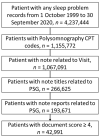Validation of a Natural Language Processing Algorithm for the Extraction of the Sleep Parameters from the Polysomnography Reports
- PMID: 36292283
- PMCID: PMC9602175
- DOI: 10.3390/healthcare10101837
Validation of a Natural Language Processing Algorithm for the Extraction of the Sleep Parameters from the Polysomnography Reports
Abstract
Background: There is a need to better understand the association between sleep and chronic diseases. In this study we developed a natural language processing (NLP) algorithm to mine polysomnography (PSG) free-text notes from electronic medical records (EMR) and evaluated the performance. Methods: Using the Veterans Health Administration EMR, we identified 46,093 PSG studies using CPT code 95,810 from 1 October 2000−30 September 2019. We randomly selected 200 notes to compare the accuracy of the NLP algorithm in mining sleep parameters including total sleep time (TST), sleep efficiency (SE) and sleep onset latency (SOL), wake after sleep onset (WASO), and apnea-hypopnea index (AHI) compared to visual inspection by raters masked to the NLP output. Results: The NLP performance on the training phase was >0.90 for precision, recall, and F-1 score for TST, SOL, SE, WASO, and AHI. The NLP performance on the test phase was >0.90 for precision, recall, and F-1 score for TST, SOL, SE, WASO, and AHI. Conclusions: This study showed that NLP is an accurate technique to extract sleep parameters from PSG reports in the EMR. Thus, NLP can serve as an effective tool in large health care systems to evaluate and improve patient care.
Keywords: natural language processing; polysomnography; sleep parameters.
Conflict of interest statement
The authors declare no conflict of interest.
Figures
Similar articles
-
Actigraphy for the assessment of sleep measures in Parkinson's disease.Sleep. 2013 Aug 1;36(8):1209-17. doi: 10.5665/sleep.2888. Sleep. 2013. PMID: 23904681 Free PMC article.
-
Polysomnographic validation of an under-mattress monitoring device in estimating sleep architecture and obstructive sleep apnea in adults.Sleep Med. 2022 Aug;96:20-27. doi: 10.1016/j.sleep.2022.04.010. Epub 2022 Apr 22. Sleep Med. 2022. PMID: 35576830
-
Validation of a physical activity accelerometer device worn on the hip and wrist against polysomnography.Sleep Health. 2018 Apr;4(2):209-216. doi: 10.1016/j.sleh.2017.12.007. Epub 2018 Jan 17. Sleep Health. 2018. PMID: 29555136 Free PMC article.
-
Prospective cohort study to evaluate the accuracy of sleep measurement by consumer-grade smart devices compared with polysomnography in a sleep disorders population.BMJ Open. 2021 Nov 9;11(11):e044015. doi: 10.1136/bmjopen-2020-044015. BMJ Open. 2021. PMID: 34753750 Free PMC article.
-
A comparison of radio-frequency biomotion sensors and actigraphy versus polysomnography for the assessment of sleep in normal subjects.Sleep Breath. 2015 Mar;19(1):91-8. doi: 10.1007/s11325-014-0967-z. Epub 2014 Mar 11. Sleep Breath. 2015. PMID: 24614968
Cited by
-
Identification of sleep phenotypes in COPD using machine learning-based cluster analysis.Respir Med. 2024 Jun;227:107641. doi: 10.1016/j.rmed.2024.107641. Epub 2024 May 6. Respir Med. 2024. PMID: 38710399 Free PMC article.
-
The Relationship between Mustard Import and COVID-19 Deaths: A Workflow with Cross-Country Text Mining.Healthcare (Basel). 2022 Oct 18;10(10):2071. doi: 10.3390/healthcare10102071. Healthcare (Basel). 2022. PMID: 36292516 Free PMC article.
-
Artificial Intelligence Models in Health Information Exchange: A Systematic Review of Clinical Implications.Healthcare (Basel). 2023 Sep 19;11(18):2584. doi: 10.3390/healthcare11182584. Healthcare (Basel). 2023. PMID: 37761781 Free PMC article. Review.
-
Development and Evaluation of a Natural Language Processing System for Curating a Trans-Thoracic Echocardiogram (TTE) Database.Bioengineering (Basel). 2023 Nov 10;10(11):1307. doi: 10.3390/bioengineering10111307. Bioengineering (Basel). 2023. PMID: 38002431 Free PMC article.
-
A case study on generative artificial intelligence to extract the fundamental sleep parameters from polysomnography notes.J Clin Sleep Med. 2025 Jun 1;21(6):1123-1127. doi: 10.5664/jcsm.11594. J Clin Sleep Med. 2025. PMID: 40012317
References
-
- Gerstenslager B., Slowik J.M. Sleep Study. StatPearls Publishing; Treasure Island, FL, USA: 2021. - PubMed
-
- Mayo Clinic Polysomnography (Sleep Study) 2022. [(accessed on 10 January 2022)]. Available online: https://www.mayoclinic.org/tests-procedures/polysomnography/about/pac-20....
-
- Bajeh A.O., Abikoye O.A., Mojeed H.A., Saliku S.A., Oladipo I.D., Abdulraheem M., Awotunde J.B., Sangaiah A.K., Adewole K.S. Intelligent IoT Systems in Personalized Health Care. Elsevier; Amsterdam, The Netherlands: 2021. Application of computational intelligence models in IoMT big data for heart disease diagnosis in personalized health care; pp. 177–206.
Grants and funding
LinkOut - more resources
Full Text Sources



